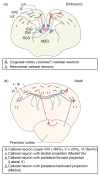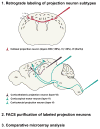Development, specification, and diversity of callosal projection neurons
- PMID: 21129791
- PMCID: PMC3053014
- DOI: 10.1016/j.tins.2010.10.002
Development, specification, and diversity of callosal projection neurons
Abstract
Callosal projection neurons (CPN) are a diverse population of neocortical projection neurons that connect the two hemispheres of the cerebral cortex via the corpus callosum. They play key roles in high-level associative connectivity, and have been implicated in cognitive syndromes of high-level associative dysfunction, such as autism spectrum disorders. CPN evolved relatively recently compared to other cortical neuron populations, and have undergone disproportionately large expansion from mouse to human. While much is known about the anatomical trajectory of developing CPN axons, and progress has been made in identifying cellular and molecular controls over midline crossing, only recently have molecular-genetic controls been identified that specify CPN populations, and help define CPN subpopulations. In this review, we discuss the development, diversity and evolution of CPN.
Copyright © 2010 Elsevier Ltd. All rights reserved.
Figures




References
-
- Schoenemann PT, et al. Prefrontal white matter volume is disproportionately larger in humans than in other primates. Nat Neurosci. 2005;8:242–252. - PubMed
-
- Aboitiz F, Montiel J. One hundred million years of interhemispheric communication: the history of the corpus callosum. Braz J Med Biol Res. 2003;36:409–420. - PubMed
-
- Peters A, Jones EG, editors. Cellular Components of the Cerebral Cortex. Plenum Press; 1984.
-
- Noctor SC, et al. Cortical neurons arise in symmetric and asymmetric division zones and migrate through specific phases. Nat Neurosci. 2004;7:136–144. - PubMed
Publication types
MeSH terms
Grants and funding
LinkOut - more resources
Full Text Sources
Other Literature Sources

